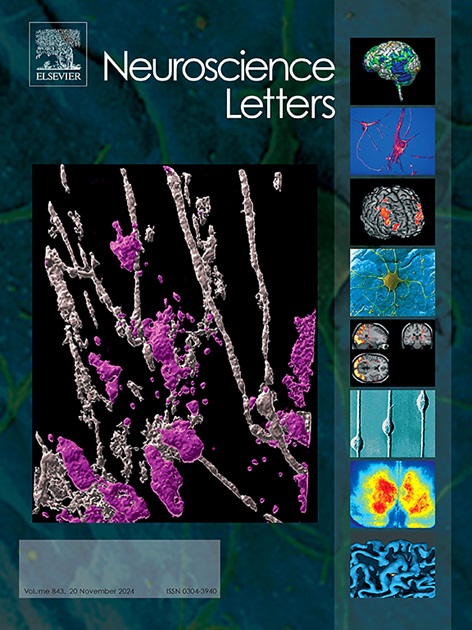啮齿类动物亚急性和慢性中风的性别特异性细胞死亡机制
IF 2.5
4区 医学
Q3 NEUROSCIENCES
引用次数: 0
摘要
为了表征性别作为中风严重程度和病理生理生物学变量的亚急性和慢性影响,10只雄性和10只雌性动物(230克和2-4个月大)在感觉运动皮层进行了光血栓性梗死。计算脑卒中后2周和4周的病变体积(5只动物/性别/时间点)。在每个时间点对病灶周围区域进行caspase-8、凋亡诱导因子(AIF)和Iba-1表达的染色。在两周(男性:11.2 mm3 vs女性:7.3 mm3, p = 0.02)和四周(男性:9.3 mm3 vs女性:4.7 mm3, p = 0.008)时,男性的病变体积明显大于女性。在两周时,女性的caspase-8/AIF比值中位数明显高于男性(男性:0.59 vs女性:2.1,p = 0.02),但在四周时这种差异不再存在(男性:6.0 vs女性:6.2,p = 0.56)。在脑卒中后2周,男性的Iba1信号显著高于女性(男性:13.7% vs女性:3.2%,p = 0.0008)。尽管在4周时男性的表达有所下降(p = 0.008),但与女性相比,Iba-1信号仍有较大的趋势(男性:5.2 vs女性:2.8,p = 0.06)。在亚急性期,雄性表现出与parthanatos和较高的神经炎症一致的模式,而雌性表现出与caspase-8介导的细胞凋亡一致的模式。在慢性阶段,两性都表现出神经炎症和caspase主导细胞死亡的减少。这些探索性发现强调了可能受小胶质细胞活动影响的神经元死亡模式的潜在性别差异,这可能值得在未来的治疗相关研究中加以考虑。本文章由计算机程序翻译,如有差异,请以英文原文为准。

Sex-specific cell death mechanisms in rodent sub-acute and chronic stroke
To characterize subacute and chronic effects of sex as a biological variable in the severity and pathophysiology of stroke, ten male and ten female animals (>230 g and 2–4 months old) underwent photothrombotic infarction at the sensorimotor cortex. Lesion volume was calculated two- and four-weeks post-stroke (5 animals/sex/timepoint). The perilesional area was stained for active caspase-8, apoptosis-inducing factor (AIF), and Iba-1 expression at each timepoint. Males demonstrated significantly larger lesion volume than females at both two- (male: 11.2 mm3 vs female: 7.3 mm3, p = 0.02) and four-week (male: 9.3 mm3 vs female: 4.7 mm3, p = 0.008). The median caspase-8/AIF ratio was significantly higher in females as compared to males at two weeks (male: 0.59 vs female: 2.1, p = 0.02), however this difference was no longer present at the four-week (male: 6.0 vs female: 6.2, p = 0.56). At two weeks post-stroke, Iba1 signal in males was significantly greater than in females (male: 13.7 % vs female: 3.2 %, p = 0.0008). Although expression decreased in males at four weeks (p = 0.008), there was still a trend towards greater Iba-1 signal in comparison to females (male: 5.2 vs female: 2.8, p = 0.06). In the subacute stage, males showed a pattern consistent with parthanatos and higher neuroinflammation, while females showed a pattern consistent with caspase-8-mediated apoptosis. In the chronic stage, both sexes exhibit reduction in neuroinflammation and caspase-predominant cell death. These exploratory findings highlight potential sex-based differences in neuronal death patterns that may be influenced by microglial activity and may warrant consideration in future treatment-related studies.
求助全文
通过发布文献求助,成功后即可免费获取论文全文。
去求助
来源期刊

Neuroscience Letters
医学-神经科学
CiteScore
5.20
自引率
0.00%
发文量
408
审稿时长
50 days
期刊介绍:
Neuroscience Letters is devoted to the rapid publication of short, high-quality papers of interest to the broad community of neuroscientists. Only papers which will make a significant addition to the literature in the field will be published. Papers in all areas of neuroscience - molecular, cellular, developmental, systems, behavioral and cognitive, as well as computational - will be considered for publication. Submission of laboratory investigations that shed light on disease mechanisms is encouraged. Special Issues, edited by Guest Editors to cover new and rapidly-moving areas, will include invited mini-reviews. Occasional mini-reviews in especially timely areas will be considered for publication, without invitation, outside of Special Issues; these un-solicited mini-reviews can be submitted without invitation but must be of very high quality. Clinical studies will also be published if they provide new information about organization or actions of the nervous system, or provide new insights into the neurobiology of disease. NSL does not publish case reports.
 求助内容:
求助内容: 应助结果提醒方式:
应助结果提醒方式:


